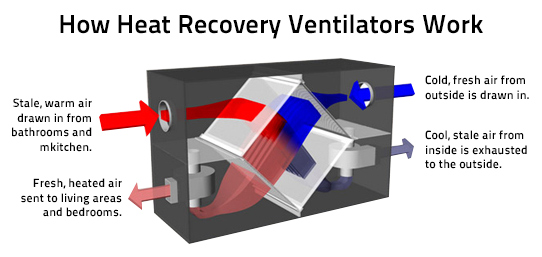The All-Inclusive Overview to the Uses of Heat Recovery Ventilation in Modern Buildings
Heat Recovery Ventilation (HRV) systems stand for a significant advancement in developing technology (HRV Heat Recovery Ventilation). They give a technique for trading stale interior air with fresh outdoor air while decreasing energy loss. This technique not only improves interior air high quality but additionally adds to energy performance in both domestic and business buildings. Comprehending the various applications and benefits of HRV can disclose its essential duty in modern design and sustainability initiatives. The implications of this innovation deserve discovering even more
Understanding Heat Recovery Ventilation Equipments

Although several modern-day buildings prioritize energy efficiency, recognizing warm recuperation ventilation (HRV) systems is vital for optimizing interior air quality and reducing energy intake. HRV systems work by transferring warmth from stale interior air to incoming fresh air, properly maintaining comfy interior temperature levels while decreasing power loss. These systems are composed of a heat exchanger, followers, and ductwork that assist in the circulation of air. Throughout winter, HRV systems catch and reuse warmth from the outgoing air, while in summer season, they can help cool incoming air. By continually trading air, HRV systems additionally lower moisture and the focus of indoor toxins. Proper setup and maintenance of HRV systems are vital for their effectiveness and efficiency in enhancing overall structure performance and convenience.
Benefits of Heat Recovery Ventilation
Heat recovery ventilation systems supply various benefits that enhance both power performance and indoor air quality in modern-day buildings. By capturing and recycling energy from exhaust air, these systems significantly reduce home heating and air conditioning costs, leading to reduced energy intake. They maintain a steady circulation of fresh outdoor air, decreasing the danger of interior air contaminants and irritants. This constant exchange aids control moisture degrees, preventing mold growth and guaranteeing a much healthier living environment. In addition, HRV systems add to sustainability goals by lowering total carbon impacts. Their capability to optimize ventilation without sacrificing thermal convenience makes them a useful addition to modern building layout, advertising both economic and environmental benefits.
Applications of HRV in Residential Buildings
As house owners significantly prioritize power efficiency and indoor air high quality, the applications of warmth recovery ventilation (HRV) systems in property structures have become more prevalent. HRV systems are particularly useful in securely sealed homes, where keeping fresh air blood circulation is necessary for stopping dampness accumulation and interior contaminants. They efficiently move warmth from outgoing stagnant air to incoming fresh air, reducing power expenses linked with heating & look these up cooling. Furthermore, HRVs can boost comfort degrees by controling moisture and temperature. They are also adaptable for different household layouts, consisting of single-family homes and multi-unit structures. On the whole, integrating HRV systems sustains lasting living techniques while ensuring a much healthier interior setting for owners.
HRV in Business and Commercial Settings
In industrial and commercial settings, the application of heat recovery ventilation (HRV) systems has actually come to be significantly critical for optimizing energy efficiency and keeping air high quality. These systems successfully transfer warmth from exhaust air to inbound fresh air, minimizing the need for additional heating or cooling. This not just lowers energy costs yet additionally adds to sustainability campaigns. Industries such as manufacturing, warehousing, and workplace structures benefit substantially from HRV systems, as they aid regulate temperature level and humidity levels, making sure a comfy and efficient setting. HRV systems aid in getting rid of pollutants and excess dampness, boosting interior air quality. As laws around air quality come to be stricter, the adoption of HRV innovation is most likely to grow, making it a vital part of modern industrial and commercial infrastructure.
Future Trends in Heat Recovery Ventilation Innovation

Often Asked Concerns
How Does Heat Recovery Ventilation Impact Indoor Air Top Quality?
Heat recovery ventilation substantially boosts indoor air quality by Full Article continually trading stale indoor air with fresh outdoor air while recovering energy. This process decreases toxins, maintains ideal humidity levels, and guarantees a much healthier setting for passengers.
Can HRV Solutions Be Installed in Existing Structures?
HRV systems can undoubtedly be installed in existing buildings. Retrofitting might call for alterations to ductwork and ventilation layouts, yet it significantly enhances power effectiveness and interior air high quality, making it a viable choice for older frameworks.
What Upkeep Is Required for HRV Equipments?

Exist Details Climates Where HRV Is Much More Reliable?
Heat recovery ventilation systems are especially reliable in environments with substantial temperature level differences between seasons. These systems enhance energy efficiency by recovering warm from exhaust air, making them optimal for both cold and reasonably warm settings.
Exactly How Do HRV Solutions Affect Energy Expenses?
